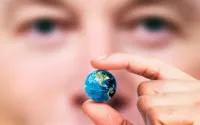Jo Anne Van TilburgFriday April 19, 2002The GuardianThor Heyerdahl, who has died of cancer aged 87, was one of the great individualistic standard-bearers of mid-20th-century adventure. In 1947, he and his five-person crew climbed aboard Kon-Tiki, an experimental balsa raft, and swept atop the Pacific's Humboldt current from Peru to the Tuamotu islands - and into history. His achievement, Heyerdahl announced to the world, proved that New World mariners from the east might have sailed into Polynesia, contradicting the general assumption that it had been populated from the west. Today, there is no question that Kon-Tiki demonstrated, in the words of archaeologist Glyn Daniel, the possibility - but not the actuality - of entering the Pacific from east to west on a balsa raft. The project lay at the heart of Heyerdahl's life's work - trying to prove his conviction that the cultures of the ancient world were sometimes linked by sailors who could cross oceans. To establish the dryland archaeological support for this hypothesis, in 1952-53 Heyerdahl travelled to the Galapagos islands, lying on the equator 500 miles to the west of Ecuador. Shards of what were suggested to be pre-Incan pots challenged the view that there had been no pre-European visitors there. This was just the prelude to his expeditions to Easter island (Rapa Nui), set remotely apart to the south-east of the Tuamotu archipelago. Following that venture, he became interested in the feasibility of crossing the Atlantic in reed boats, and then in the possibility of ancient feats of seafaring in the Arabian sea and Indian ocean. Streaming through all the extensive body of published work that Heyerdahl produced is the complex, contradictory persona of a man who thought like an outsider, but not an outcast. Demanding, opinionated, but sensitive and kind, throughout his career he stubbornly cast himself in steady counterpoint to academia. He refused to play by the most basic rules of academic interchange, yet bristled when faced with criticism, and promptly took his case to the welcoming court of public opinion. There was, he said in a recent interview, a "shocking extent of ignorance" on the part of those who "call themselves authorities and pretend to have a monopoly of all knowledge". None the less, every archaeologist who ever worked with Heyerdahl liked and respected him. Born in Larvik, Norway, Heyerdahl was the lonely, only son of unhappy, estranged parents who divorced during his early childhood. Entering Oslo University to study zoology and geography, he changed to anthropology while living in Fatu-Hiva in the Marquesas islands of French Polynesia, having become fascinated by the question of where its inhabitants had come from. There he shed the conventions of normal life - including the completion of his degree course - and, like so many earlier South Seas travellers, artists and poets, embarked on his own internal journey. As Pacific historian Gavin Daws put it, Heyerdahl was determined to turn his personal quest "into accomplishments that the world will pay attention to". And this he did. The next step, from 1939 to 1940, was to pursue his theory of native American movements into the Pacific by looking for a "missing link" in British Columbia. He believed that an early Stone Age people from south-east Asia had crossed the Pacific to north America, and had set off again for Polynesia at some point before 1000AD. Certain artefact and language characteristics suggested to him that there might be a connection between peoples in Malaysia, Polynesia and - at the apex of this distended and still unproven theoretical triangle - some of the native American tribes of British Columbia. From 1941, Heyerdahl fought in the free Norwegian military forces in Finnmark, at Norway's northernmost extremity. He then conducted further research in Europe and the US from 1945 to 1947. The Kon-Tiki expedition took its name from a mythical seafarer king who, in a legend of the Aymara Indians of Lake Titicaca, in modern Bolivia, had set off across the seas with his followers and disappeared: such folk mem-ories formed yet another strand in Heyerdahl's radical view of ancient technology and enterprise. The bearded face, representing the early ocean sailor, adorned the sail of the modern craft. From Callao, Peru, to the island of Raroia, in Polynesia, it covered 4,300 miles in 101 days. In 1948, the day after his second marriage had taken place in Santa Fe, New Mexico, Heyerdahl met the American archaeologist Edwin N Ferdon Jr. At the time, Heyerdahl was lecturing and raising funds to support his book American Indians In The Pacific: The Theory Behind The Kon-Tiki Expedition, a controversial tome published in 1952. One of his chief interests was to trace the origins of Rapa Nui's megalithic sculpture, and to seek evidence of the relationship he believed it had to South American traditions. Ferdon joined the Norwegian expedition to Rapa Nui at Heyerdahl's invitation, and the two men embarked upon a rewarding friendship that, in spite of distance and differing opinions, endured for 50 years. William Mulloy (who told an amused Heyerdahl, "I don't believe a damn thing you've published"), Arne Skjölsvold and Carlyle S Smith made up the rest of the archaeological team. Very soon after the expedition landed on the island, Heyerdahl called the other archaeologists into the expedition's base tent. "You know my theories," he said, and then instructed them to go their own ways without fear of interference. He was open-minded and always fair, even when their results failed to prove his theories. In 1958, Heyerdahl published Aku Aku: The Secret Of Easter Island, an imaginative, even fanciful, but engrossing yarn of "secret caves" and "ghostly" ceremonies, woven around the island's imposing sculptures, and stories of a mythical conflict between long- and short-eared people. It became immensely popular mainstream reading, and encouraged a welcome upsurge in modern tourism to the island. Those interested in more solid information turned to the expedition's formidable formal report. Edited by Heyerdahl and Ferdon in 1961, it is a landmark in Pacific studies and a monument to the project. The presence of the sweet potato, an indigenous South American plant, in southeast and central Polynesia by 1000AD remains the best and most convincing evidence of human contact between the two regions. In 1919, Katherine Routledge, who with her husband William Scoresby had been a pioneering predecessor of Heyerdahl's, had written that reaching Rapa Nui from South America was "out of the question". More recent investigations, summarised by New Zealand scholar Roger Green, suggest a more cautious evaluation. Green, who met Heyerdahl for the first time at the Pacific science congress in Honolulu in 1961, differed with him on many issues. Perhaps the most important of them was the raft as a means of contact between South America and Polynesia. Heyerdahl, Green said, "just had things backward". The contact, most Pacific scholars believe, had been from south-east Polynesia to the northern South American coast and then back again. The two men held other contradictory opinions, but each regarded the other as a colleague and good friend. Thus, the question that Kon-Tiki first posed so dramatically more than 50 years ago is still open, and current archaeology is pursuing it according to the agenda that Heyerdahl advanced. In Peru, Heyerdahl had become acquainted with the use of small reed boats on Lake Titicaca. Excavations on Rapa Nui had uncovered images of what he believed were three-masted reed boats, and this led Heyerdahl to speculate whether such vessels, apparently known in ancient Egypt and still constructed by the Buduma people from Lake Chad, could have crossed the Atlantic. His 1969 voyage from Morocco in Ra I proved that a papyrus ship could survive ocean conditions for a long time, though its stern threatened to disintegrate after covering 3,000 of the 4,000 miles to Barbados. However, Heyerdahl and his collaborators came to appreciate that the inwardly curled stern they discerned in some ancient Egyptian pictures was not ornamental. It was essential to a vessel's elasticity, and so Heyerdahl enlisted the aid of four Aymara Indians from Bolivia; the second attempt, in Ra II a year later, reached Barbados. The Tigris expedition of 1977-78 built on the knowledge gained during the course of the Ra voyages. Heyerdahl sought to prove that Mesopotamian berdi reed could equally well have provided the material for Sumerian boat-builders to get to the Red Sea and Egypt, to the west, and to the ancient civilisations of the Indus Valley, to the east. In the course of building Tigris, Heyerdahl introduced his Aymara Indian comrades to their Iraqi Marsh Arab counterparts: despite the language barrier, the two groups worked together to build a ship that was, at more than 50ft, Heyerdahl's largest. But when wars in the Red Sea region confined it to Djibouti harbour, he burnt it in protest. His expeditions to the Maldive islands in 1983 and 1984 followed, blossoming out of his belief that these coral reefs had been known to seafarers long before their discovery by Arabs in 1153. Then, in 1986, 1987 and 1988, he returned to Rapa Nui with two main objectives. A story told in the early 1900s claimed that the island's great statues were capable of "walking". Working with a Czechoslovak engineer named Pavel Pavel, Heyerdahl tied ropes to the top and to the bottom of a small, upright statue, and then crews pulling on the ropes wriggled it back and forward, moving it about four feet. The method was impractical in the island's rugged terrain, and Heyerdahl did not pursue it, or other land-based theories, with the passion he brought to sea voyage experimentation. His other aim concerned the toromiro tree, which is endemic to Easter island. In 1956, he had taken seeds from a dying specimen and had them planted in the Gothenburg botanical garden. While the tree was not extinct, its numbers had been greatly diminished. He encouraged conservation efforts by re-establishing seedlings in the plant nursery of the island's national park. Among the pyramids of Túcume, Peru, from 1988 to 1993, Heyerdahl found what he believed was proof of his original Kon-Tiki hypothesis: "images of reed ships crewed by mythical men with bird heads" - symbolic motifs similar to others found in petroglyphs on Rapa Nui. In 1990, more pyramids took him to Güímar, Tenerife, in the Canary islands, where he met his third wife, Jacqueline, and bought a house; the couple married in 1996. He theorised that the Tenerife pyramids had an astronomically oriented temple function, and took them to have been left by the Guanche people, who had surrendered to the Spaniards. In one of the final examples of the sweeping, global connections that he loved to make, he described their king as "the last of the white and bearded seafarers that were only kept alive in the legends in Mexico and Peru". Heyerdahl published extensively, lectured widely, made documentary films - the 1951 Oscar-winning Kon-Tiki left an indelible impression - received numerous awards and was granted several honorary degrees. He encouraged conservation and environmental awareness, had a wide public that he was very conscious of, and enjoyed the undisputed celebrity status of world figure and Norwegian national treasure. In the field of Polynesian studies he made three significant and enduring contributions: the notion of the sea as connector, not a barrier; the now indisputable fact of contact between South America and Polynesia; and his generous support of modern arch- aeology. Heyerdahl and the Kon-Tiki Museum in Oslo (founded in 1949 with his wartime colleague and radio operator on the raft, Knut Haugland) have initiated, raised money for, or published the results of, projects in Rapa Nui, Pitcairn, the Marquesas islands, South America and, most recently, in Western Samoa. His thirst for knowledge and experience provided the driving force for new archaeological discoveries. When Heyerdahl revisited Rapa Nui in 1984, the islanders put on an enormous welcome, and he graciously attended dozens of public and private affairs in his honour. I was there as an archaeology graduate student, and held a special dinner at the house I was renting in the village, complete with Rapa Nui children in dancing costume. Heyerdahl came and, as I recall, danced with abandon with my then eight-year-old daughter. Over the following years, we had heated differences of opinion over issues related to the statues, but we also had marvellous, stimulating conversations. Rapa Nui people are grateful to him for bringing their history to the attention of the world, and archaeologists Sonia Haoa and Sergio Rapu, like many other colleagues, appreciated his love of tackling big, complex questions, and encouraging others to do the same. Kon-Tiki and Heyerdahl's other larger-than-life adventures were all, in the words of Robert Louis Stevenson, "a voyage to a further goal". The growth of knowledge, Heyerdahl knew, is never neatly linear. He took us all on a magnificent, exploratory sail, tacking restlessly from one direction to another, but always heading toward a new island just over the horizon, and always before the wind. Heyerdahl was married three times. He had two sons from his first marriage to Liv, whom he married in 1936. His second wife was Yvonne, whom he married in 1948; they had three daughters, one of whom predeceased him. His third wife, Jacqueline, survives him, along with his two sons and two daughters. Thor Heyerdahl, voyager, explorer and writer, born October 6 1914; died April 18 2002 Guardian Unlimited © Guardian Newspapers Limited 2002
Kâinatın tüm seslerine, renklerine, titreşimlerine Açık Radyo...
Ekolojiden siyasete, edebiyattan müziğe Apaçık Radyo'da haftanın öne çıkan gündemleri mail kutunuzda!
İletişim
Açık Medya Yayıncılık A.Ş.
Koltukçular Çıkmazı No 7 İç Kapı No 2
Tophane, Beyoğlu, İstanbul, TR-34425
Telefon: +90 212 343 4040
Faks: +90 212 232 3219
E-posta: [email protected]






